
Seated exercises for seniors are a fantastic way to stay active and maintain overall health and well-being.
While some may think that exercise is only for the young and agile, these sitting exercises are specifically designed to cater to the needs and abilities of seniors.
Now, lets get right into it…
Navigation
Benefits of Seated Chair exercises for Seniors
There are tons of benefits for older adults doing seated exercises, some even better than those of other regular exercises.
Perfect for seniors with limited mobility
These exercises can be done from the comfort of a chair, making them accessible to individuals with limited mobility or balance issues more than standing exercise. It can also when done consistently rehabilitate and improve balance and mobility.
Bone and Joint Health
Often challenge your muscles, to build better strength in bones and joints.
If you are ready, grab a sturdy chair and get ready to move!
Precautions and Safety Tips for Senior Sitting Exercises
While sitting exercises are generally safe, it’s essential to take certain precautions to prevent injury and ensure a comfortable experience. Here are some tips:
Choosing the Right Exercises for limited mobility
Everyone is different, so it’s crucial to choose sitting exercises that align with your abilities and limitations.
Start with gentle movements and gradually increase intensity as you become more comfortable. Listen to your body and modify exercises as necessary.
Safety Tips and Guidelines for Proper Form
Maintaining proper form during sitting exercises is essential to prevent strain or injury. Ensure that you sit with a straight posture, engage your core muscles, and avoid sudden or jerky movements.
Take breaks if needed, stay hydrated, and don’t push yourself beyond your limits.
Consulting with a Healthcare Professional
Before starting any exercise program, it’s a good idea to consult with a healthcare professional, especially if you have any pre-existing medical conditions or concerns.
They can provide personalized advice and help you determine the most suitable exercises for your needs.
Best chair exercises for seniors: low-impact chair workout!
Maintaining proper form during sitting exercises is essential to prevent strain or injury. Ensure that you sit with a straight posture, engage your core muscles, and avoid sudden or jerky movements.
Take breaks if needed, stay hydrated, and don’t push yourself beyond your limits.
Upper-Body chair workout for Seniors
Now that we’ve covered the importance of sitting exercises and safety tips, let’s dive into some specific exercises for the upper body:
Before we start, remember, to always have a full range of motion!
Shoulder & Arm exercises:
1. “Lateral Raises”
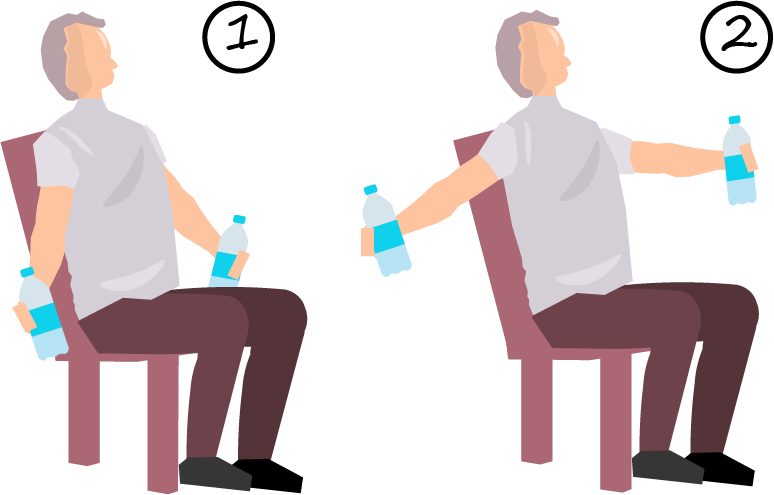
Repetitions: 7-9 Sets: 2 Pause between sets: 30 sec
To strengthen your arms and shoulders, start with seated lateral raises. For the starting position simply sit upright with your feet flat on the ground, hold a lightweight object (like a water bottle or dumbbell) in each hand, and raise your arms out to the sides until they are parallel with the floor.
Keep your elbows fully stretched. Lower the arms back down, return to the starting position and repeat for repetitions.
Chest and Back exercise:
2. “seated chest press”
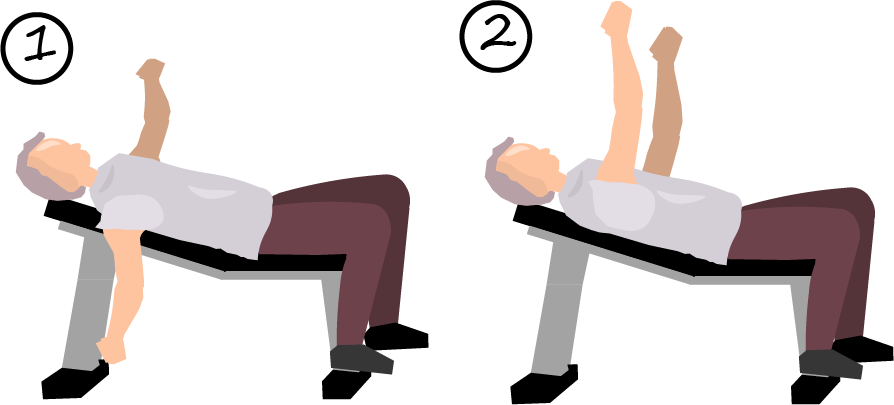
Repetitions: 10-12 Sets: 3 Pause between sets: 30 sec
To work your chest and back muscles, try seated chest presses. Sit upright and hold a resistance band or weights at chest level.
Make sure your shoulder blades face inwards to each other. Push your arms straight out in front of you, extending your elbows fully. Bring your arms back towards your chest and repeat.
Hand and Finger Exercise:
3. "finger taps"
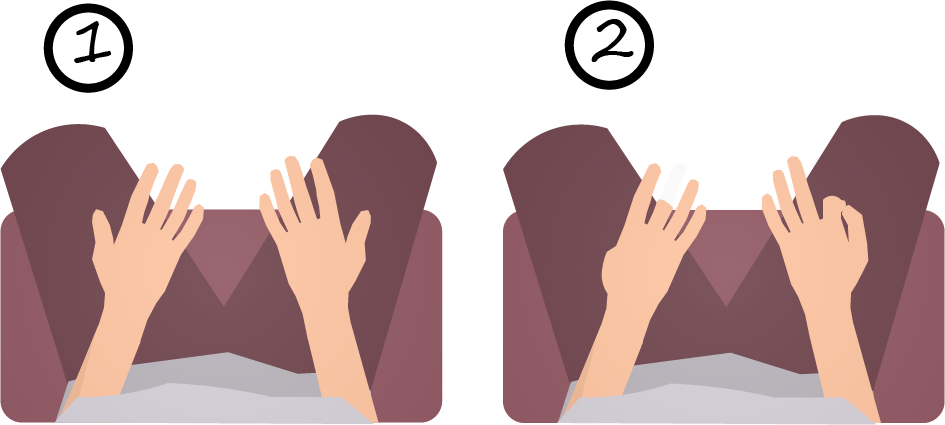
Repetitions: 40 Sets: 5 Pause between sets: 10-15 sec
To improve hand and finger dexterity, try finger taps. Place your hands comfortably on your thighs and quickly tap each finger of one hand to your thumb. Repeat with the other hand. This exercise helps maintain coordination and flexibility in the hands.
Remember, sitting exercises should be enjoyable and tailored to your needs. Incorporate them into your daily routine, and you’ll be on your way to better health and well-being in no time!
Lower-Body chair workout for Seniors
Knee & Leg Exercises
1. “Leg Raises”

Repetitions: 10-12 Sets: 3 Pause between sets: 30 sec
When it comes to keeping our lower body strong and limber, leg raises a great place to start.
First sit comfortably on your chair with your legs shoulder-width apart from each other, feet firmly planted on the ground and your back straight.
Simply sitting in a chair, you can lift your right leg and bend your right knee upfront, extending it straight out in front of you as far as it goes. Hold for a few seconds and then lower it back down.
Repeat on the other, one leg at a time. This exercise helps to strengthen the quadriceps and improve knee stability.
Ankle & Foot Exercise
2. “Ankle rotation and raises”
Repetitions: 13-14 Sets: 2 Pause between sets: 60 sec
Don’t forget about your ankles and feet!
To keep them in tip-top shape, try these simple exercises. While seated, flex and point your feet, moving your ankles up and down. You can also try rotating your ankles in circles, both clockwise and counterclockwise. These exercises help to improve circulation and maintain flexibility in your lower extremities.
Hip & Thigh Strengthening Exercise

Repetitions: 10-11 Sets: 2 Pause between sets: 30-40 sec
Strong hips and thighs are crucial for maintaining balance and mobility. To work on these areas, try standing in front of a sturdy chair and place one foot firmly on the center of the chair.
Hold for a few seconds and then bring it back in. Finish about ten repetitions and then repeat on the other leg. This exercise targets the hip abductor muscles and helps to improve stability.
Core Strengthening Exercise for Seniors
Abdominal Exercise
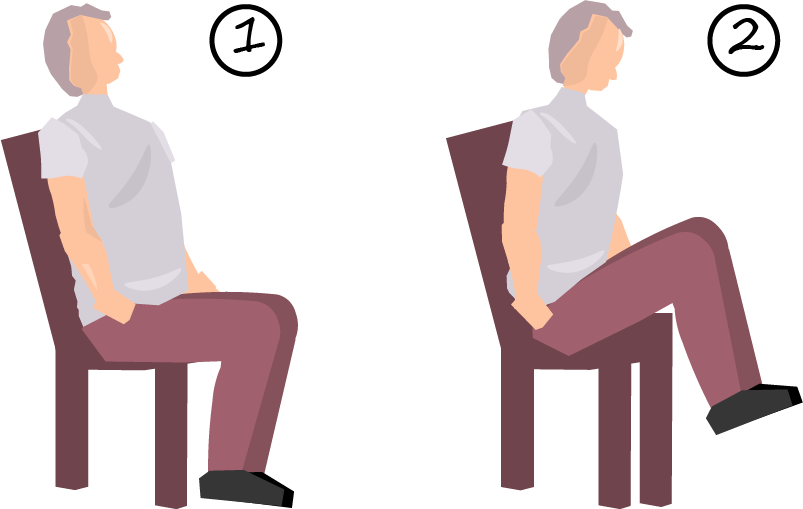
Repetitions: 8 -11 Sets: 3 Pause between sets: 25 sec
A strong core is the foundation for a healthy body. To strengthen your abdominal muscles, try seated crunches by leaning forward slightly and bringing your chest towards your knees.
Back Strengthening Exercise
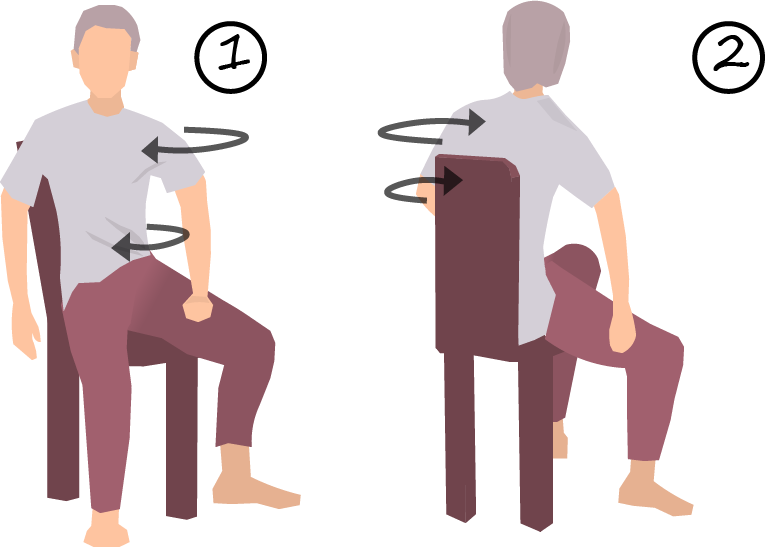
Repetitions: 12-13 Sets: 2 Pause between sets: 15 sec
Back pain is a common issue for many seniors, but with the right exercises, you can help alleviate discomfort. While comfortably in the chair, gently twist your upper body to one side and hold for a few seconds. Then, twist to the other side. This exercise targets the muscles in your lower back and promotes flexibility.
Core Stability Exercise
Controllable intensity!
In addition to strengthening your core muscles, it’s important to work on stability. Sit on an exercise ball and find your balance. [Affiliate Link]
Engage your core to maintain an upright posture. To make it more challenging and engaging you can move the ball while maintaining posture. This exercise helps to improve balance and stability, which are essential for everyday activities.
Stretching and Flexibility Exercises for Seniors
Neck and Shoulder Stretches

Repetitions: 4 Sets: 2(each side) Hold for: 15 sec
After long periods of sitting, our neck and shoulder muscles can feel tight and tense. To relieve this discomfort, gently tilt your head, sitting a little on the edge of your chair from side to side, bringing your ear towards your shoulder. You can also try rolling your shoulders forward and backward to release tension.
Have your leg straight on a 90 degree angle and plant your feet firmly on the ground. These stretches help to improve flexibility and reduce stiffness.
Incorporating Sitting Exercises into Daily Routine
Creating a Routine and Setting Realistic Goals
When it comes to incorporating sitting exercises into your daily routine, consistency is key. Start by creating a schedule and setting realistic goals.
Maybe it’s committing to 10 minutes of exercises every morning or incorporating short exercise breaks throughout the day. Find what works for you and stick to it.
Making Sitting Exercises a Habit
To make sitting exercises a habit, try to find ways to make them enjoyable. Listen to your favorite music or audiobook while exercising, or find a workout buddy who can join you in your sitting exercises. By making it fun, you’ll be more likely to stick with it and make it a regular part of your routine.
Can You Lose Belly Fat in Your seat?
Chair exercises for seniors can indeed help in losing belly fat. Engaging in regular physical activity, even if it’s done in a seated position, can increase calorie expenditure and promote weight loss. These exercises target the abdominal muscles, assisting in toning and strengthening them. Additionally, chair exercises improve overall fitness levels and enhance flexibility, which indirectly contributes to burning belly fat.
However, it is important to pair these exercises with a healthy and balanced diet for optimal results!
FAQ
1. Can sitting exercises really benefit seniors? What are the true benefits of chair exercises?
Yes, sitting exercises can be extremely beneficial for seniors. They help improve strength, flexibility, balance, and overall mobility. Sitting exercises are designed to be safe and accessible for individuals with limited mobility or physical limitations.
2. Are there any precautions to consider before performing chair exercises?
Prior to starting any exercise routine, it’s important for seniors to consult with a healthcare professional, especially if they have any existing health conditions or concerns. Additionally, it’s crucial to listen to your body and start with exercises that are appropriate for your fitness level. If you experience any pain or discomfort, it’s advisable to stop and seek guidance from a professional.
3. Can sitting exercises be combined with other forms of physical activity?
Absolutely! Sitting exercises can be a great complement to other forms of physical activity. Seniors can incorporate sitting exercises into their daily routine alongside activities like walking, swimming, or yoga. It’s important to find a balance and choose exercises that work well together to create a comprehensive fitness program.
4. How often should seniors engage in sitting exercises?
The frequency of sitting exercises can vary depending on an individual’s fitness level and overall health. It’s generally recommended for seniors to aim for at least 2-3 sessions per week. However, it’s essential to listen to your body and gradually increase the frequency and duration of exercises as you feel comfortable and confident.

